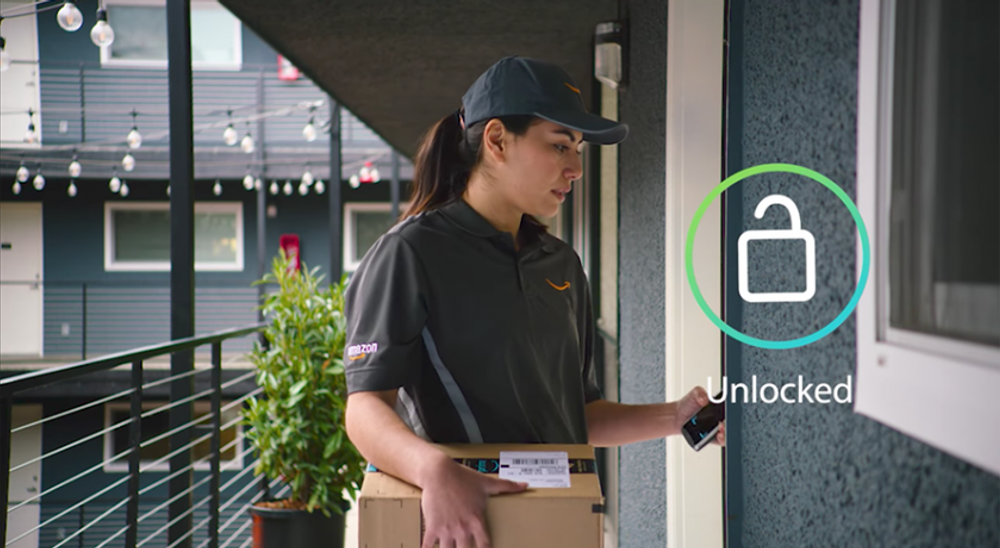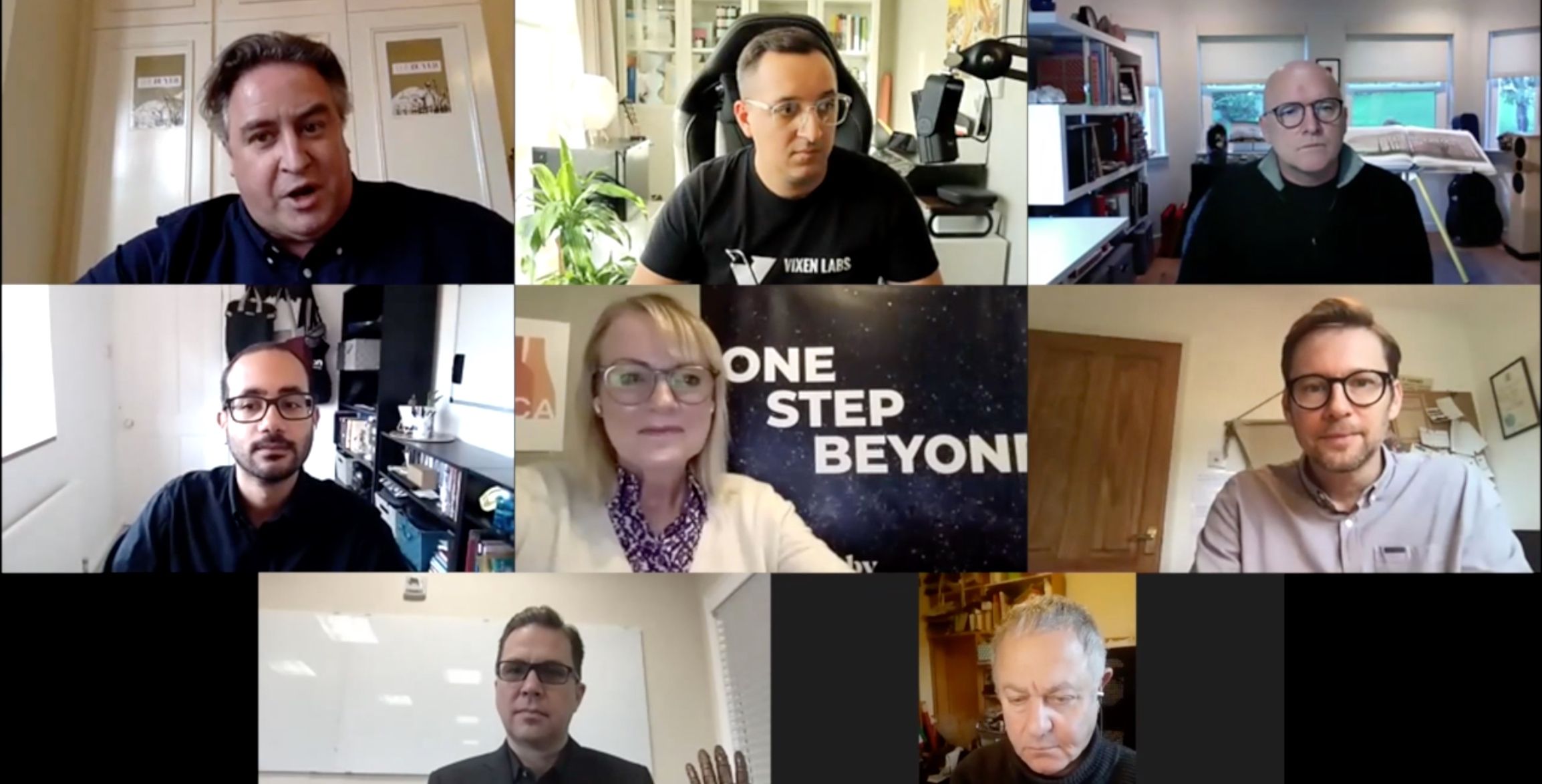As well as our analysis and short video extracts from the One Step Beyond webinar you can also watch the full conference on YouTube here. Our thanks go to our partners, the Wine & Spirit Trade Association, and digital consultancies, Emetry and 5Forests.
When The Buyer sat down with Sophie Jump just over 12 months ago and came up with what became the One Step Beyond initiative, we wanted to address the huge changes taking place in technology and its impact on consumer behaviour. We could not, though, have imagined just how far and fast our every day way of living would have changed so dramatically during 2020.
Even when we held the inaugural One Step Beyond conference in March, Covid-19 was still (at least from a UK perspective) happening elsewhere and had not yet been a factor in our lives. How wrong we were.

The inaugural One Step Beyond conference was organised by Sophie Jump and The Buyer’s Richard Siddle
But at least that first event was able to take place. For those that were able to attend it gave them the chance to hear first hand from experts outside the drinks industry about the work, expertise and developments taking place around smart technology, digital marketing, voice search, Artificial Intelligence, design, packaging and a whole lot more.
All issues and topics that might not be directly about how wines, beers and spirits are made, but they are very much about how they are then brought to market and sold.
Trends that have all been stretched, pulled and put on fast forward during the long months of lockdown and Covid-19 that have followed.
All change please
In order to capture and assess just what changes have taken place since March 2020 and, in particular, what the drinks, retail and hospitality sectors need to be most on top of, we brought back the same expert speakers and panelists that took part in the first One Step Beyond conference, and held an online conference – for free – that anyone could take part in. Wherever they were in the world.
Their brief was tight and specific. To capture the most important, fast changing trends in their area of expertise in a series of 10 minute presentations.
The response we received showed just how much interest there now is in the digital world and what we as individuals and businesses need to be doing to address it. We had around 400 people from countries all over the world sign up and just under 200 take part in the live session.
The beauty of online means the webinar is still available to watch, in full, here – click below
But to give you a guide as to what to expect here is the first of our edited highlights starting with the presentation of Naji El-Arifi, head of innovation of Wunderman Thompson Commerce, the e-commerce, omni channel and social media experts.
Over the coming weeks we will be running further articles focusing in on the presentations given by:
- James Poulter, chief executive, Vixen Labs – specialists in voice search and digital.
- Paul Mabray, chief executive, Emetry – digital insights experts for the wine industry.
- James Harmer, planning and strategy leader, Cambridge Design Partnership – experts in commercial design and packaging.
- Kevin Shaw, chief executive, Stranger & Stranger – drinks design and packaging agency.
- Simon Mayhew, head of online retail insight, IGD – analysts for the grocery and FMCG sectors.
- And the drinks industry panel between:
- Lucy Auld, head of marketing – Freixenet Copestick.
- Illy Jaffar, managing director, Kinetic Creative Communications – brand consultancy for the drinks and entertainment industry.
- Liam Hirt, director, Circumstance Distillery – craft distillers.
- Robert Joseph – drinks industry consultant.
Covid Consumer

Naji El-Arifi of Wunderman Thompson Commerce speaking at the first One Step Beyond conference in March on the opportunity for ecommerce
First up was Naji El-Arifi at Wunderman Thompson Commerce who looked specifically at how Covid19 is impacting how and where consumers are looking to spend their money.
The first thing, he says, to understand is that the Covid-19 crisis, according to their work and research is not forcefully changing consumer behaviour in its own right, but is more acting as a catalyst to accelerate existing trends that were already taking place.
To better understand what those trends are Wunderman Thompson Commerce has broken them down into eight key areas – detailed analysis of each one is available from them directly:
1 Digital commerce is on the rise.
2 Amazon influence is increasing on the overall B2C market.
3 Brands and DTC companies will increasingly have to fight it out on a “war of service, delivery, availability and returns”.
4 Omni-channel – and what having a Covid-19 vaccine might bring.
5 Products and services need to be digitised.
6 Environmental concerns are a growing factor in online behaviour.
7 Social media and social commerce – what next?
8 Voice and zero user interface are going to be part of our future.
Rise in digital commerce
For the One Step Beyond presentation El-Arifi focused in on the rise in digital commerce and how the battle for online sales is going to play out between classic brands and the growing DTC sites and economy.
Although we have seen an enormous switch to online retailing during lockdown, that is only building on what was already happening prior to Covid, he says.
Wunderman’s research from April found that overall 65% of 14,000 consumers in UK, US, France, Spain, Germany, Netherlands and Australia all expected to spend more online in 2020. That was as high as 93% in China and 72% amongst 26-24 year-olds.
Click here for Naji El-Arifi of Wunderman Thompson Commerce on the key trends driving digital commerce
Covid spending trends
It then looked at online spending trends pre, during and potentially post Covid-19 and found that:
- Pre Covid 43% of UK and 38% of US shoppers were regularly spending online.
- During lockdown that went up to 62% in the UK and 56% in the US.
- Looking ahead when there is a vaccine and things are back to near normal then 51% of UK shoppers expect to shop online and 45% in the US.
- Lockdown has also seen 43% of UK shoppers feel positive about the experience and 47% in the US.
The lockdown experience, though, appears to have changed shoppers for good. Wunderman claims:
- 66% of UK shoppers said their purchasing behaviours have changed for good.
- Only 16% intend to carry on with how they were shopping and behaving before Covid-19.
- Habits and behaviours learnt in lockdown are going to be embedded for the long term.
- Particularly around using technology with 38% of consumers now saying they are comfortable with using it which opens up online for so much more business.
- The fact grandparents and grandchildren are now comfortable talking to each other via Zoom shows how far we have come so quickly.
Balanced e-commerce strategy
(Click here for Naji El-Arifi, Wunderman Thompson Commerce on what an effective e-commerce strategy should look like)
It is one thing selling online, it is another doing it well, which is why Wunderman places so much emphasis on companies having what it calls a “balanced e-commerce strategy”. This was particularly demonstrated during lockdown where those businesses that did not have a multi pronged approach online missed out.
Wunderman calls on businesses to ensure they have these bases covered:
- Selling your products through marketplaces like Amazon.
- Going through traditional online retailers.
- Having a DTC platform and capability.
- Developing a social commerce strategy to be able to sell through social media platforms.
How to get DTC right
The one big area that is really driving e-commerce is DTC, but how do you do that right? El-Arifi says it is about potentially thinking differently to how you might do working with traditional on and off-trade channels. The best DTC operators do three things right:
- They give their consumers what they want and are not focused on themselves. The main reason why products fail in DTC.
- Get that right and those consumers will then be prepared to go out of their way to shop with you.
- Concentrate fully on WACD – “What Amazon can’t do.”
Wunderman has spoken to company chiefs of a range of online and DTC businesses to assess what it is that causes products and brands to fail online. Here’s what those chiefs say:
- 34% say it is down to “lack of alignment” with customer needs.
- 29% admit to poor logistics not being able to meet demand.
- 29% a lack of clear objectives.
- 28% put it down to a lack of digital knowledge, skills and talent in the business.
- 28% said they did not have a robust enough strategy to make it work.
All of which are pretty damning, but also pretty quick to put right, stresses El-Arifi, with the right customer journey mapping online and focus groups with core customers to get your product offer right in the first place.
What does your consumer want?
Click here for Naji El-Arifi, Wunderman Thompson Commerce on consumer expectations around DTC
Clearly if you going to get any of this right then you need to make sure you actually know what your consumer wants. For Wunderman that means getting these three right:
- Delivery
- Availability
- Returns
That is backed up by its research that shows the top 5 reasons a consumer will shop with one online retailer over another are:
1 61% Free delivery.
2 57% Availability.
3 53% Better prices.
4 49% Fast delivery.
5 Convenient delivery.
So not a lot there about having the right vintage, blend of grape varieties or the fact the wine producer you are buying from online is third or fourth generation.
Perfecting DTC
Being good online is all about how good you are at delivering your products, stresses El-Arifi. Even if you are a well known household brand it is not the fact buying direct will give you better access to you as a business (only 16% wanted more information about products), or you can get the full range on line (28% of shoppers).
The number one factor that will dictate a consumer buying direct from a brand is:
77% Price.
54% Free delivery.
32% Fast delivery.
32% Convenient delivery.
When Wunderman Thompson looks to work with a brand to help them improve their DTC offer it will look at all those factors individually stop see how well they perform. But in general terms they can be broken down into how well a brand or business is able to achieve high scores for the following:
- Price
- Service
- Content
- Curation
- Personalisation
- Access
“If you can perfect these areas you can really create an experience that is going to make people keep coming back to you and keep wanting to purchase directly from you,” he says.
Perfecting Delivery

Amazon is now so engrained in our lives that it is trialling a new service whereby we will give permission to its delivery drivers to come in to our homes if we are out.
The benchmark for how fast a product can be bought and delivered to your door is being set by industry leaders such as Amazon. It might feel unfair to be compared to what Amazon can do, but when it comes to delivery that’s what consumers will do.
The average online shopper expects to get a delivery within 2.85 days, which drops to 1.62 days for those who see themselves as “digital leaders”.
A fifth of all 18-24 year olds won’t buy from any online retailer if they cannot be guaranteed next day delivery. Amazon, he says, has made it “almost normal” to have products delivered the next day.
In the first lockdown there was a wider acceptance amongst 70% of shoppers that it would take longer than normal for products to be delivered, but that leeway has waned the longer it has gone.
What consumers want online to do better
One way you can get ahead of your competition is to do better in the areas that consumers want online retailers and brands to do better. Wunderman Thompson has picked out six key issues they want to see improve with returns and delivery key:
- 28% Free returns.
- 25% Easy returns.
- 24% Faster replacement of products out of stock.
- 24% Faster delivery.
- 23% Clearer signposting about products out of stock.
A big wake up call for brands from the Wunderman research is that although brands are still important in what products consumers want to buy (24% very important and 52% quite important) some 38% say they would swap to another brand if it meant they could get the product to them on time.
“We think that number will increase in next year’s study,” says El-Arifi.
Major takeaways
The major takeaway from El-Arifi’s presentation was the need for brands to think less about what they stand for as a product online, but how reliable and trusted are you by your prospective customer to get your brand to them when they want. Service, delivery and availability are what will define your success online, he says. Then how good you are at also dealing with and handling returns.
It’s all those ‘consumer service’ elements that are the most important when it comes to succeeding in DTC, he says.
- Watch the full One Step Beyond webinar here.










































